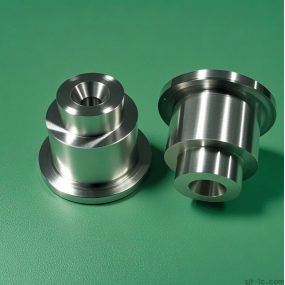Aluminum alloy materials have excellent functions such as low density, outstanding electrical and thermal conductivity, and are widely used in industries such as aviation, aerospace, military, scientific research, fine instruments, high-precision medical equipment, etc. They are also common processing materials in machining centers.
In aluminum alloy five axis machining, due to the low strength and hardness of aluminum alloy, low cutting load, good thermal conductivity, and fast heat dissipation, the melting point of aluminum alloy is relatively low, around 600, and aluminum alloy debris easily sticks to the drill bit, forming chip lumps. These factors affect the machinability of aluminum alloy five axis machining when using machining centers to cut aluminum alloy raw materials.
Firstly, aluminum alloy raw materials are soft, and the spindle speed should be appropriately increased within the range accepted by the tool. The feed rate should be minimized as much as possible. If the feed rate is large, it will be difficult to remove chips from the entire machining process. When machining aluminum alloy workpieces with five axes, it is necessary to fully clamp and support the workpiece, and maintain sharp cutting tools. Otherwise, the workpiece often tends to leave the cutting tool. If irregular groove marks and bright kneading spots appear on the surface of the workpiece during processing, one possibility is that the pressure of the tool on the workpiece is abnormal, and another possibility is that vibration is caused by unstable clamping. When the tool rubs against the surface of the workpiece in a gap like manner, kneading and powder cutting occur. Then, when the gap or elasticity disappears, the tool bites into the surface of the workpiece, forming groove marks. Aluminum alloy workpieces require a high degree of surface smoothness, so special attention should be paid during processing.
Secondly, in order to reduce the occurrence of chip deposits in aluminum alloy five axis machining, especially to avoid the residue of chip deposits from adhering to the front when they disappear, the front and rear cutting surfaces of the drill bit cutting edge should be polished to 0.8 μ m or more with an oilstone, and it is better to choose a drill bit with a polished edge groove. In order to achieve a smooth surface of the workpiece, it is advisable to choose a combination of drilling first and then expanding the hole, as various qualified aluminum alloy workpiece blanks will always have some oxide layers, which will increase the wear of the drill bit.
Ultimately, the selection of cutting fluid is crucial in the five axis machining process of aluminum alloys. It is necessary to ensure excellent lubrication, cooling, filtering, and rust prevention. Therefore, the cutting fluid that can be used for five axis machining of aluminum alloys is different from ordinary cutting fluids.
When performing aluminum alloy five axis machining, a large amount of heat is generated due to high-speed machining. If the generated heat cannot be carried away by the cutting fluid in a timely manner, it will cause tool sticking phenomenon, and in severe cases, chip accumulation will occur, which will seriously affect the machining precision of the workpiece and the service life of the tool. At the same time, heat can also cause deformation of the workpiece, seriously affecting the accuracy of the workpiece. Therefore, the selection of cutting fluid should take into account both lubricity and cooling function. For precision machining of aluminum alloys, low viscosity cutting oils or semi composition anti friction cutting fluids can be selected.


 Spanish
Spanish Arabic
Arabic French
French Portuguese
Portuguese Belarusian
Belarusian Japanese
Japanese Russian
Russian Malay
Malay Icelandic
Icelandic Bulgarian
Bulgarian Azerbaijani
Azerbaijani Estonian
Estonian Irish
Irish Polish
Polish Persian
Persian Boolean
Boolean Danish
Danish German
German Filipino
Filipino Finnish
Finnish Korean
Korean Dutch
Dutch Galician
Galician Catalan
Catalan Czech
Czech Croatian
Croatian Latin
Latin Latvian
Latvian Romanian
Romanian Maltese
Maltese Macedonian
Macedonian Norwegian
Norwegian Swedish
Swedish Serbian
Serbian Slovak
Slovak Slovenian
Slovenian Swahili
Swahili Thai
Thai Turkish
Turkish Welsh
Welsh Urdu
Urdu Ukrainian
Ukrainian Greek
Greek Hungarian
Hungarian Italian
Italian Yiddish
Yiddish Indonesian
Indonesian Vietnamese
Vietnamese Haitian Creole
Haitian Creole Spanish Basque
Spanish Basque











